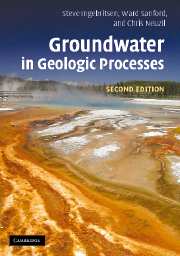Book contents
- Frontmatter
- Contents
- Preface
- Acknowledgements
- List of symbols
- 1 Groundwater flow
- 2 Hydromechanical coupling
- 3 Solute transport
- 4 Heat transport
- 5 Regional-scale flow and transport
- 6 Ore deposits
- 7 Hydrocarbons
- 8 Geothermal processes
- 9 Earthquakes
- 10 Evaporites
- 11 Compaction and diagenesis
- 12 Metamorphism
- 13 Subsea hydrogeology
- References
- Index
4 - Heat transport
Published online by Cambridge University Press: 12 January 2023
- Frontmatter
- Contents
- Preface
- Acknowledgements
- List of symbols
- 1 Groundwater flow
- 2 Hydromechanical coupling
- 3 Solute transport
- 4 Heat transport
- 5 Regional-scale flow and transport
- 6 Ore deposits
- 7 Hydrocarbons
- 8 Geothermal processes
- 9 Earthquakes
- 10 Evaporites
- 11 Compaction and diagenesis
- 12 Metamorphism
- 13 Subsea hydrogeology
- References
- Index
Summary
In this chapter we derive general equations describing groundwater flow and heat transport, introduce several useful dimensionless parameters, and describe simple quantitative approaches to such specific processes as one-dimensional flow, buoyancy-driven flow, and heat pipes. In later chapters we will describe applications of the theory outlined here to regional-scale heat transfer (Section 5.4), ore genesis (Chapter 6), hydrocarbon maturation (Chapter 7), and geothermal processes (Chapter 8).
General models of hydrothermal circulation in the Earth's crust must accommodate a temperature range of 0 ◦C (near the surface) to 1200 ◦C (the approximate basalt solidus). Corresponding fluid pressures might range from 0.1 MPa (atmospheric pressure) to 1000 MPa (the approximate lithostatic pressure at 40-km depth). Over this pressure–temperature range, water can exist as liquid, vapor (steam), or supercritical fluid. On the macroscopic (volume-averaged) scale at which we model hydrologic systems, water can also be regarded as comprising a two-phase mixture of liquid and steam. We will consider heat as being advected by the moving fluid and conducted through the rock–fluid medium. “Conduction” refers to the transfer of kinetic, rotational, and vibrational energy according to a temperature gradient. We use “advection” to denote the transport of heat (or solutes) by fluid movement. Heat advection is generally more effective than conduction where volumetric rates of fluid flow are greater than 1 cm per year.
Governing equations
Here we will develop equations that describe the flow and transport of pure water and heat. A fuller description would consider the effects of solutes and noncondensible gases on fluid properties and include coupled descriptions of solute transport like those developed in the previous chapter. However, systems of equations more complex than those considered here are difficult to solve, even numerically, and the pure-water assumption is reasonable for many applications. The pure-water assumption is discussed further in Section 4.1.7.
Pressure and enthalpy as dependent variables
Groundwater flowand heat transport can be described by a set of coupled equations expressing mass and energy conservation. At first inspection it might seem reasonable to pose these equations in terms of hydraulic head and temperature, respectively. However, the familiar groundwater flow formulation in terms of head (Section 1.5) is predicated on essentially constant fluid density.
- Type
- Chapter
- Information
- Groundwater in Geologic Processes , pp. 124 - 156Publisher: Cambridge University PressPrint publication year: 2006



